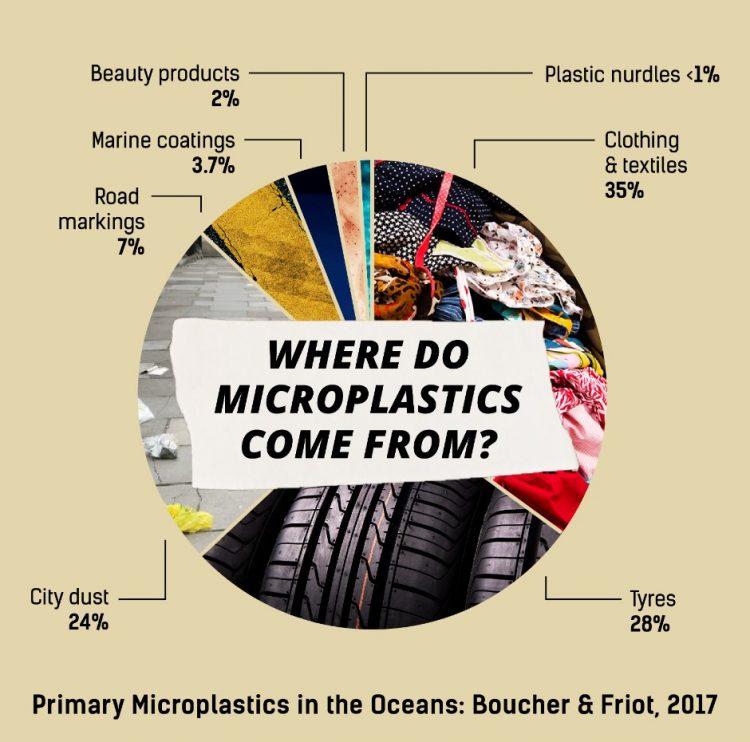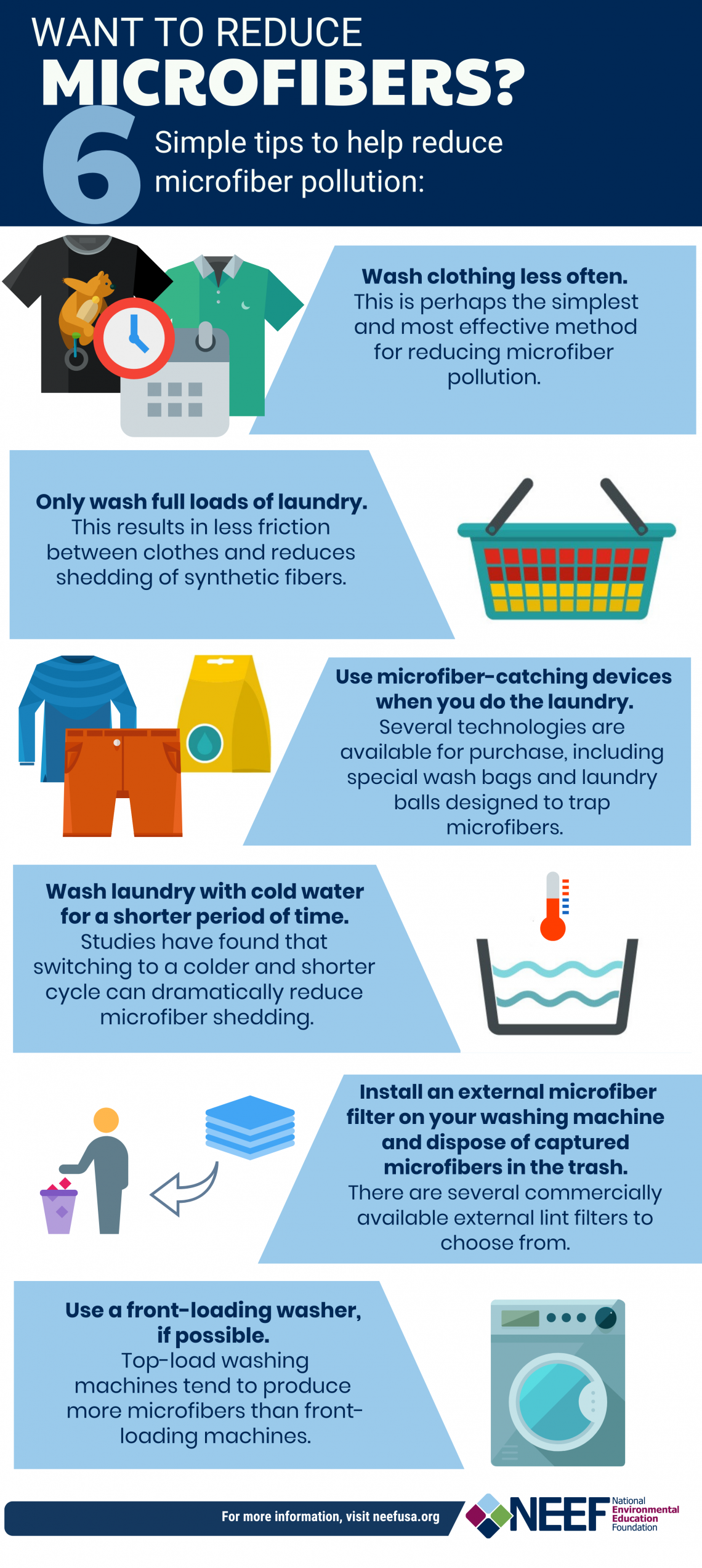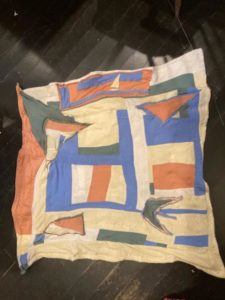The fashion industry accounts for about 10% of our global carbon emissions and 20% of its wastewater, not to mention the millions of microplastics shed into the ocean from washing machines.
Calculate your closet’s climate change impact by taking this short and fun survey.
Rethink:
Clothing and other textiles are primarily responsible for the presence of microplastics in the ocean (accounting for 35%, according to the poster below left). Refer to this exhaustive clothing guide by Fibershed to avoid clothing made from plastic-derived fibers.
To make clothes last longer — and shed fewer microplastics into the environment — simply wear them longer before washing. This Guardian article has good suggestions for how to delay having to wash your clothes. The poster below right offers other tips to reduce microfiber pollution.


Another tip: Avoid using dryers as much as possible. The heat and all that tumbling around wears out the fibers faster,
Ultimately, limiting the amount of synthetic clothing that you buy and wear is key to solving this issue long-term.
Tips for Laundry Day
Excerpted from The Secret to Longer-lasting Clothes Will Also Reduce Plastic Pollution, by Alisha McDarris
Start by separating your clothing items—not by color, but by material. Wash rough or coarse clothes like jeans separately from softer items like polyester T-shirts and fuzzy fleece sweaters. This way, you reduce the friction caused by rougher materials crashing into more delicate ones for 40 minutes. Less friction means your clothes won’t wear out as fast and the fibers will be less prone to premature breakage.
Then, make sure you’re using cold water instead of hot. Heat weakens fibers and makes them more likely to break; cold water will help them last longer. Next, run a short cycle instead of a normal or long one, which will limit the opportunity for fiber breakdown. While you’re at it, reduce the speed of the spin cycle if you can—this will reduce friction even further. One study showed that together, these methods reduced microfiber shedding by 30 percent.
While we’re on the subject of washer settings, avoid the delicate cycle. That may run contrary to your beliefs, but it uses more water than other washing modes to prevent friction—and a higher ratio of water to fabric actually increases fiber shedding.
Finally, skip the dryer altogether. We can’t emphasize this enough: heat can shorten the life of materials and make them more likely to break in the next load of laundry. Fortunately, synthetic clothing dries fast, so hang it outside or over your shower rod instead—you might even save money by not running your dryer so frequently.
Once your clothes are washed and dried, don’t go back to the washer for a while. Many items don’t need to be washed after every use, so put those shorts or that shirt back in the dresser for another wear or two if it doesn’t smell like wet dog after one use. If there’s just one dirty spot, wash it out by hand instead of starting a load.
There are also several tools you can use to reduce microfiber shedding. Guppyfriend makes a laundry bag specifically designed to capture broken fibers and microplastic waste, but also to prevent fiber breakdown in the first place by protecting clothing. Just place your synthetics inside, zip it shut, toss it in the washer, and pick out any and dispose of any microplastic lint that gets caught in the corners of the bag. Even standard laundry bags help reduce friction, so those are an option as well.
A separate lint filter that attaches to your washing machine’s discharge hose is another effective and endlessly reusable option, shown to reduce microplastics by up to 80 percent. But don’t spring for those laundry balls that are supposedly meant to catch microfibers in the wash: the beneficial results are comparatively minimal.
Here are eight tips for giving socks a longer life.
Repurpose:
Cashmere, silk, linen, wool, leather – If you have holey or stained clothing made of these fibers, or if you have fabric scraps of the same, Amos Staffler will gratefully accept them.
Please drop off at 309 Wallace Way NW (off Grow) or she can pick up from you if you email her.
She notes that when cashmere with a hole or silk with a stain is donated to Goodwill, it doesn’t get sold as a garment for a second life; it gets diverted to be ground up as fiber filling because it isn’t saleable as a garment. So keep those pieces local and give to Amos. She snips and puzzles cashmere and silk together to make new creations and gives the precious fibers a second life. From quilts to all sorts of garments, it’s become a sustainable form of expression that she feels good about. In fact, she recently donated a cashmere & linen all-season baby blanket (pictured right) to the Seattle Children’s Thrift Store on Bainbridge.
to be ground up as fiber filling because it isn’t saleable as a garment. So keep those pieces local and give to Amos. She snips and puzzles cashmere and silk together to make new creations and gives the precious fibers a second life. From quilts to all sorts of garments, it’s become a sustainable form of expression that she feels good about. In fact, she recently donated a cashmere & linen all-season baby blanket (pictured right) to the Seattle Children’s Thrift Store on Bainbridge.
Reuse:
Check the “Borrow, Buy, Sell, Trade, Repair” section on the ReFashion Bainbridge resource page.
To read about the pros and cons of various second-hand shopping online sites, go here.
This blog has plenty of ideas for reusing and upcycling old t-shirts.
Check with local thrift stores to donate gently used items.
- Seattle Children’s Bargain Boutique
- Waterfront Thrift Shop – located in the Senior Center
Recycle:
Good and bad condition, damaged, torn, stained, and worn clothing, shoes, and fabrics. Nothing wet wet, moldy or having hazardous material traces.
- Goodwill (Ace Hardware parking lot) – Open every day, 8:30am-5pm, or until the truck is full. Unwearable items may become wiping and polishing cloths or are turned into fibers for things like upholstery, insulation and furniture stuffing.
- Northwest Center dropboxes – Located in Eagle Harbor Church parking lot, Via Rosa parking lot
- Marine Layer – 319 Pine St., Seattle. Give them your old t-shirts and receive $5 credit up to $25. Clothing in the store is very environmentally friendly.
Compost (maybe?) :
If reuse or recycling is not possible, consider composting natural fabrics. Please read this very useful article first.
NEVER put them in curbside or transfer station yard waste. However, if you have backyard composting, you may want to give it a try.
Last updated 4/14/2024
